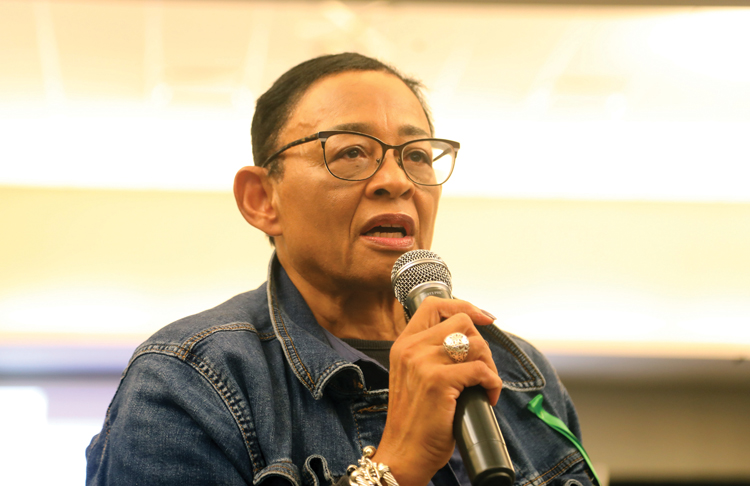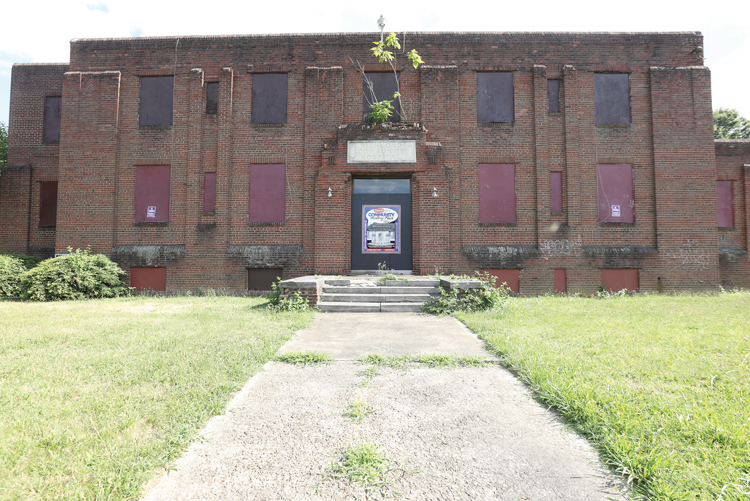Historic hospital’s fate hangs in balance as debate continues
George Copeland Jr. | 8/15/2024, 6 p.m.
Plans for the partial demolition of Richmond Community Hospital, the city’s first Black hospital, were met with mixed reactions last Thursday as Virginia Union University and developers unveiled details of a multimillion-dollar housing project during a community meeting.
VUU officials and developers presented housing information and renderings during a community discussion at the Claude G.
Perkins Living and Learning Center to a crowd of about 100 people, leading to condemnation and celebration from some attendees.
 Viola Baskerville, co-organizer of the Save Richmond Community Hospital Group, spoke about VUU’s development plans Aug. 8 at a community meeting held at the school.
Viola Baskerville, co-organizer of the Save Richmond Community Hospital Group, spoke about VUU’s development plans Aug. 8 at a community meeting held at the school.“If the community sees that building destroyed, it would be devastating,” said Viola Baskerville of the Save Community Hospital group. “The community is not against development, it is against demolition.”
The renderings included plans for incorporating the hospital building, first opened in the 1930s to provide medical care to African Americans. The building’s front, cornerstone and sign would be part of one of two six-story buildings at the site. A total of 200 housing units would be built in its place at the site, with bricks from the former hospital also incorporated into the construction.
An additional 100 housing units will be part of a mixed-use development project, called Gateway North, at the corner of Brook Road and Lombardy Street. The Brook/Overbrook project will be handled by the Steinbridge Group, while the Hanson Company will handle the Brook/Lombardy project.
“I’m trying to balance economics, I’m trying to balance the needs of the community, I’m trying to balance what Virginia Union needs in the form of revenue,” said Garfield Antonio, vice president of development for the Steinbridge Group and leader of the Brook/Overbrook Development Project. “This is unpopular, but the building has sat for a number of years.”
 The current state of the former Richmond Community Hospital building, constructed in 1932. Photos by Regina H. Boone/Richmond Free Press
The current state of the former Richmond Community Hospital building, constructed in 1932. Photos by Regina H. Boone/Richmond Free Press The incorporation of the hospital is part of planned commemorations of its staff and history, and include naming green spaces and structures for Black doctors such as hospital co-founder Sarah Garland Jones, and producing oral histories of the hospital.
The commemorative effort will cost $5 million, alongside the projected $40 million for the development.
The details provided marked the most comprehensive update since VUU announced in February its plan to redevelop parts of the area through a housing development partnership with Steinbridge.
The announcement that the hospital could face demolition sparked months of community pushback, including gatherings outside the building.
The discussion among attendees largely focused on the partial demolition of the hospital building, with questions and criticism over its use leading to back-and-forth responses between VUU and development officials and the audience.
People connected to the hospital through birth, work or family, historic preservationists and others were among those challenging the plans and advocating for the building’s rehabilitation and reuse.
“For Virginia Union not to recognize the importance related to the community hospital — it is insulting,” said J. Maurice Hopkins, who accused the school of focusing on profit. “Our legacy, our history is being washed away, and you’re responsible!”
Not everyone was critical of the development plans. Some in the audience saw it as a way to ensure VUU’s survival through a new venture and a fair compromise to maintain the hospital’s legacy.
“I completely understand and relate to the passion and comments that have been made regarding the preservation of the hospital,” VUU graduate Pamela Parker said. “But I personally want to applaud the efforts of your companies in trying to create a way to save Virginia Union.”
VUU President and CEO Hakim J. Lucas pushed back against criticism of the plan and their choice to decline offers by groups like Historic Richmond to assess the building and provide suggestions to preserve and incorporate it into the development.
“Let us be clear [...] this is not uninformed at all,” Lucas said. “The decision is not rooted in money at all. It’s rooted in one thing that’s important to all students here — housing.”
Additional questions focused on the ownership of the land following construction, the apartment’s affordability, the percentage of rent that would go to VUU and the college’s decision to involve itself in housing development.
“It’s not affordable. We’re talking about one- and two-bedroom apartments for the most part - $2,000 a month,” School Board member and City Council candidate Kenya Gibson said in a social media post after the meeting. “Same stuff we’ve seen all over the city.”
The organization of the meeting also drew some scrutiny.
Although it was billed as a chance for public clarity, non-VUU attendees and media outlets were barred from livestreaming or recording the event.
Construction on the Steinbridge development is set to start by the end of 2024, and both it and Gateway North are expected to be finished in 2025.







